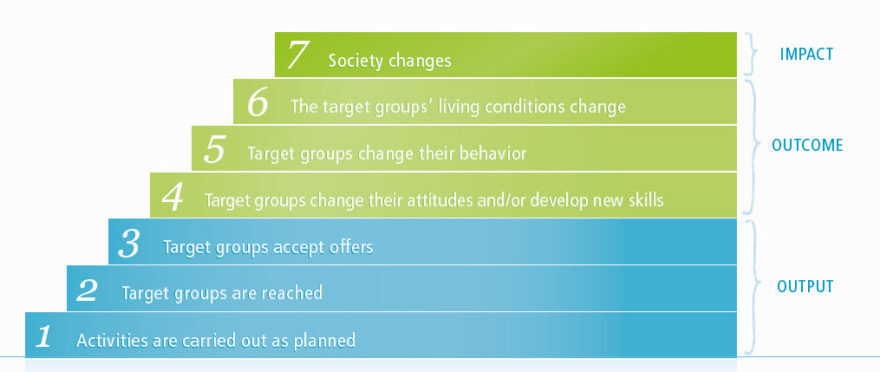What is social impact?
Every day, people get involved to change things for the better. They invest money and their heart and soul to help the disadvantaged, to protect nature or to promote culture in the neighbourhood.
In short: With their work, they try every day anew to advance society and achieve the greatest possible impact.
But what does the term “impact” mean in this context?
With reference to charitable work, the term “impact” is used in simple terms whenever a measure leads to changes in the community.
- in the target group,
- in their living environment and
- in society as a whole.
There are different levels that can achieve impact:

(This image shows: 1 Activities are carried out and planned — 2 Target groups are reached — 3 Targed groups accept offers — 4 Target groups change their attitudes and/or develop new skills — 5 Target groups change their behaviour — 6 Target groups’ living conditions change — 7 Society changes // see the translated image )
Because this is very theoretical, we explain it with an example:
Impact, very practical
A non-profit association has determined through an environment analysis that there is a great need for qualification measures for the unemployed. So it offers qualifying training to help unemployed people back into employment.
Its output (“Output”, levels 1 – 3) consists, for example, of the number of training courses and the number of participants reached.
However, taking only the resources used (“input”) and the outputs into account, this does not say anything about the actual impact of the measure! After all, a high number of participants and the personal satisfaction of those responsible for the project do not guarantee that the unemployed will acquire knowledge and skills that are relevant to the labour market — and that the project will thus contribute to the actual goal: a return to work.
The actual impact of the project is that the participants in the training courses acquire skills and build up self-confidence!
Only this change in the target group (“Outcome”, levels 4 – 6) enables them to re-enter the job market. And finally, this brings about a change at the social level (“Impact”, level 7) in the form of a decrease in unemployment, for example in the district.
Details are explained in the “Course book Impact”, which is available for free download below, and on the site “Effective Project Management for Associations and Nonprofits” …
Measuring and analysing impact
First of all: Social impact cannot be measured easily! Non-profit work cannot be based on a grid that measures and compares the respective impact — following the pattern: Organization A has an impact of 1.8 and Organization B one of 3, so Organization A is the more effective of the two.
However, the potential impact can be analysed. It is possible to make a valid assessment of the performance of a non-profit organisation and the likelihood that a project will have an impact.
And this is where PHINEO comes in: We analyze how high the impact potential of a project is and how strong the organization behind it is.
Our method of analysis is based on a scientific procedure that has been tested in the UK, which we have significantly refined and adapted to the structures of the nonprofit sector in Germany.
Our PHINEO analysis is based on eight criteria
- The objectives and target groups of the project should be clearly aligned with the respective social challenges. After all, the more precisely a project is geared to the needs of the target groups, the more likely it is to have an impact.
- The approach and concept of a project must be theoretically sound and sufficiently proven in practice. All measures should be optimally suited to the objective and the target group. The examination of projects in the environment is also relevant.
- Continuous quality development also contributes to effectiveness. In an active learning culture, work results are measured according to clear standards and, depending on the result, the concrete project work is further developed in a goal-oriented manner.
- Vision and strategy give an organisation a clear direction. Genuine impact orientation requires that an organisation’s planned action steps are suitable for actually achieving the long-term goals set.
- Leadership and personnel management form the framework for effective engagement. Depending on the size of the organization, tasks and responsibilities should be clearly defined and appropriate to the competencies involved.
- Every organization needs appropriate supervision and control mechanisms (“checks and balances”). Dependencies and personal interdependencies should be excluded, and finances should be audited by independent persons.
- Finances and controlling are fundamental to the management of an organisation. The accounts should be prepared in accordance with recognised principles. We also check the financing concept as well as the source and use of funds.
- Transparency and public relations work are also important for effective engagement, especially since social investors often make their support dependent on open information about project work, governance and the financial situation.
To leave nothing to chance, we subdivide these eight criteria into 21 sub-criteria. Each of these criteria, both individually and collectively, reveals how impact-oriented an organization’s work is and how high the potential is for the project to achieve a high degree of social impact.
Organisations and projects that want to achieve a high impact can and should be guided by these criteria.
Order & Download

Social Impact Navigator
Our Bestseller: Effective project management for nonprofit organizations. Choose your language